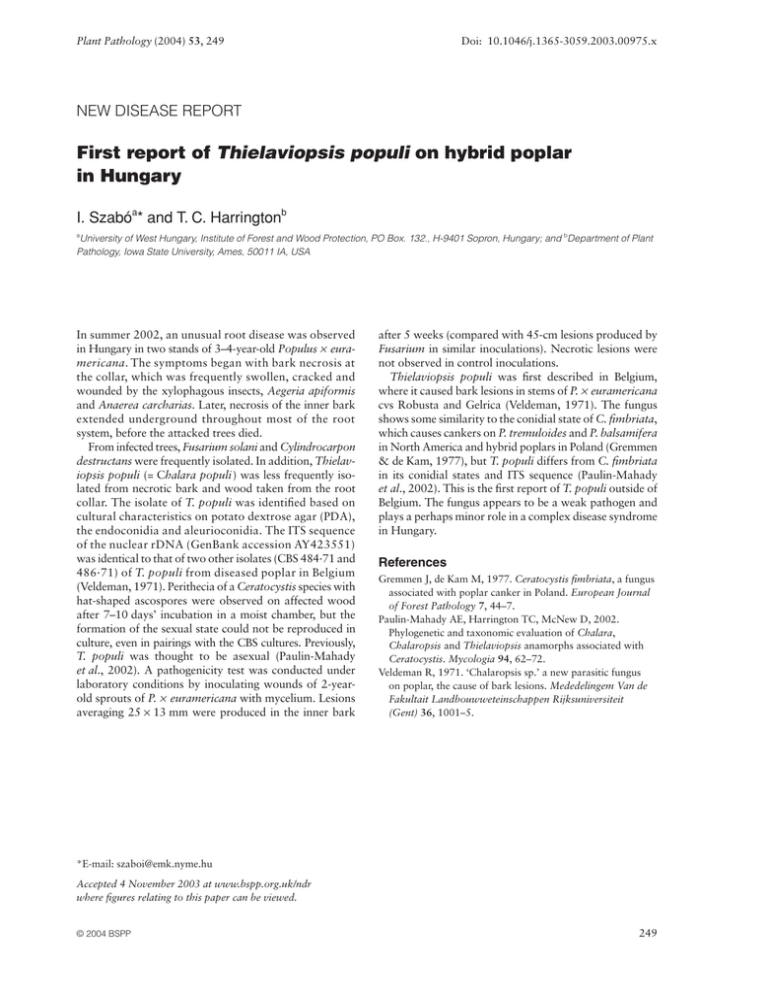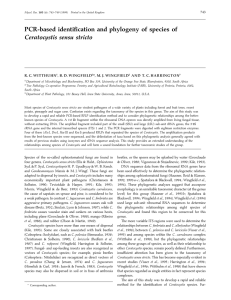First report of on hybrid poplar in Hungary
advertisement

Plant Pathology (2004) 53, 249 Doi: 10.1046/j.1365-3059.2003.00975.x NEW DISEASE REPORT Blackwell Publishing, Ltd. First report of Thielaviopsis populi on hybrid poplar in Hungary I. Szabóa* and T. C. Harringtonb a University of West Hungary, Institute of Forest and Wood Protection, PO Box. 132., H-9401 Sopron, Hungary; and bDepartment of Plant Pathology, Iowa State University, Ames, 50011 IA, USA In summer 2002, an unusual root disease was observed in Hungary in two stands of 3–4-year-old Populus × euramericana. The symptoms began with bark necrosis at the collar, which was frequently swollen, cracked and wounded by the xylophagous insects, Aegeria apiformis and Anaerea carcharias. Later, necrosis of the inner bark extended underground throughout most of the root system, before the attacked trees died. From infected trees, Fusarium solani and Cylindrocarpon destructans were frequently isolated. In addition, Thielaviopsis populi (= Chalara populi) was less frequently isolated from necrotic bark and wood taken from the root collar. The isolate of T. populi was identified based on cultural characteristics on potato dextrose agar (PDA), the endoconidia and aleurioconidia. The ITS sequence of the nuclear rDNA (GenBank accession AY423551) was identical to that of two other isolates (CBS 484·71 and 486·71) of T. populi from diseased poplar in Belgium (Veldeman, 1971). Perithecia of a Ceratocystis species with hat-shaped ascospores were observed on affected wood after 7–10 days’ incubation in a moist chamber, but the formation of the sexual state could not be reproduced in culture, even in pairings with the CBS cultures. Previously, T. populi was thought to be asexual (Paulin-Mahady et al., 2002). A pathogenicity test was conducted under laboratory conditions by inoculating wounds of 2-yearold sprouts of P. × euramericana with mycelium. Lesions averaging 25 × 13 mm were produced in the inner bark after 5 weeks (compared with 45-cm lesions produced by Fusarium in similar inoculations). Necrotic lesions were not observed in control inoculations. Thielaviopsis populi was first described in Belgium, where it caused bark lesions in stems of P. × euramericana cvs Robusta and Gelrica (Veldeman, 1971). The fungus shows some similarity to the conidial state of C. fimbriata, which causes cankers on P. tremuloides and P. balsamifera in North America and hybrid poplars in Poland (Gremmen & de Kam, 1977), but T. populi differs from C. fimbriata in its conidial states and ITS sequence (Paulin-Mahady et al., 2002). This is the first report of T. populi outside of Belgium. The fungus appears to be a weak pathogen and plays a perhaps minor role in a complex disease syndrome in Hungary. References Gremmen J, de Kam M, 1977. Ceratocystis fimbriata, a fungus associated with poplar canker in Poland. European Journal of Forest Pathology 7, 44–7. Paulin-Mahady AE, Harrington TC, McNew D, 2002. Phylogenetic and taxonomic evaluation of Chalara, Chalaropsis and Thielaviopsis anamorphs associated with Ceratocystis. Mycologia 94, 62–72. Veldeman R, 1971. ‘Chalaropsis sp.’ a new parasitic fungus on poplar, the cause of bark lesions. Mededelingem Van de Fakultait Landbouwweteinschappen Rijksuniversiteit (Gent) 36, 1001–5. *E-mail: szaboi@emk.nyme.hu Accepted 4 November 2003 at www.bspp.org.uk/ndr where figures relating to this paper can be viewed. © 2004 BSPP 249




